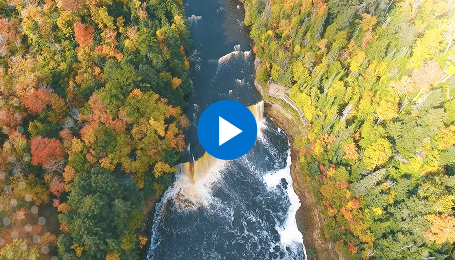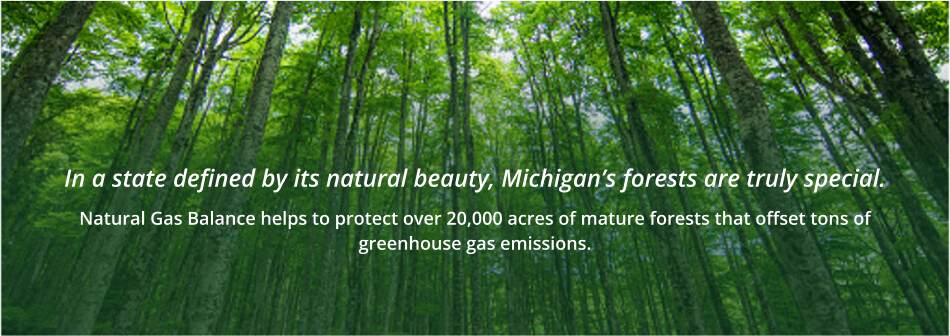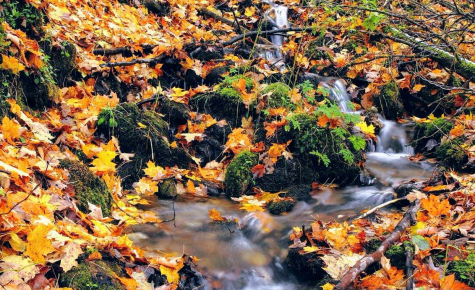 We're sorry. This program is full and not accepting new enrollments.
We're sorry. This program is full and not accepting new enrollments.
 We're sorry. The address selected is not eligible. You may need to select another address. Please review the program's Terms & Conditions.
We're sorry. The address selected is not eligible. You may need to select another address. Please review the program's Terms & Conditions.
 We're sorry. Your account isn't eligible for this program. You must be a DTE natural gas customer. You may be eligible for our MIGreenPower renewable energy program.
We're sorry. Your account isn't eligible for this program. You must be a DTE natural gas customer. You may be eligible for our MIGreenPower renewable energy program.
 Thank you for your interest, but this account is not eligible for DTE CleanVision Natural Gas Balance. Your account must be in good standing. If you have questions, please email us.
Thank you for your interest, but this account is not eligible for DTE CleanVision Natural Gas Balance. Your account must be in good standing. If you have questions, please email us.
 Thank you for your interest, but this account is not eligible for DTE CleanVision Natural Gas Balance. There have been two or more instances of insufficient funds in the past 12 months. Please contact us at (833) 628-4270 for more information.
Thank you for your interest, but this account is not eligible for DTE CleanVision Natural Gas Balance. There have been two or more instances of insufficient funds in the past 12 months. Please contact us at (833) 628-4270 for more information.
Benefits



An easy way for you to balance your carbon footprint
You can balance your greenhouse gas emissions, help preserve Michigan’s forests and make a positive impact today and for future generations by participating in Natural Gas Balance. Residential and small business natural gas customers can easily and effectively balance carbon emissions from heating, water heaters, appliances and more for a small monthly charge. Watch the video to learn how Natural Gas Balance can help you make a difference.

An easy way for you to balance your carbon footprint
You can balance your greenhouse gas emissions, help preserve Michigan’s forests and make a positive impact today and for future generations by participating in Natural Gas Balance. Residential and small business natural gas customers can easily and effectively balance carbon emissions from heating, water heaters, appliances and more for a small monthly charge. Watch the video to learn how Natural Gas Balance can help you make a difference.

When you join the Natural Gas Balance community, you help:

Balance all or some of your carbon footprint from natural gas usage, and you can change your participation level at any time.

Protect more than 20,000 acres of mature Michigan forests. Sustained, healthy forests act as natural “scrubbers” that absorb and balance carbon dioxide (CO2) produced from burning natural gas through our everyday usage.

Expand development and use of renewable natural gas (RNG). Methane emitted from landfills and wastewater treatment plants is trapped and impurities are removed, creating a cleaner source of natural gas for our homes and businesses.
To enroll your business or get help enrolling your home, please email us or call (833) 628-4270.
Natural Gas Balance Impact
Join the community of DTE gas customers making a difference today and for generations to come.


Customers enrolled


Metric tons of natural gas-related
CO2-e emissions balanced


Equivalent number of cars
off the road

Frequently Asked Questions
Frequently Asked Questions
About Your Participation

You are eligible to enroll in Natural Gas Balance if you are a DTE residential or small business natural gas customer and your account is in good standing. During enrollment you will select one of four impact levels. Please also review the program’s terms and conditions.

After enrolling in Natural Gas Balance, your participation level begins within your next two billing cycles. Your Natural Gas Balance impact level will show in the “Programs you are enrolled in” section of your monthly statement. No additional equipment or building modifications are required.

Yes. You may change your level of participation once per month and your change will go into effect in the following billing cycle.
To change your level of participation or leave Natural Gas Balance, please return to this page and sign in to your DTE account to review and make changes. You can also email us or call us at (833) 628-4270.
About Your Environmental Impact

Your participation in Natural Gas Balance directly benefits Michigan’s environment by helping to protect our state’s forests and by supporting the development of renewable natural gas. The program supports carbon offsets produced from Michigan forests, including parcels of the Greenleaf Project near Pictured Rocks and in Marquette County. We contracted with Anew, a leader in creative solutions for climate risk, to manage carbon offsets and protect and preserve more than 20,000 acres of Michigan’s forests.
DTE works in partnership with industry developers in Improved Forest Management (IFM) projects that promote sound forest management and enhance the health and resilience of Michigan's trees, including removing underbrush and planting new trees. Sustained, healthy forests act as natural “scrubbers” that absorb and balance carbon dioxide (CO2) produced from burning natural gas.
Natural Gas Balance also supports DTE’s commitment to renewable natural gas, which addresses greenhouse gas effects of methane by capturing methane gases from landfills and other waste facilities, cleans the natural gas and then redistributes it onto the energy grid.

The amount of emissions balanced is based on the natural gas usage of an average DTE customer’s home. The average DTE residential customer’s annual gas usage is 89 Mcf.*
* Quantities of natural gas are usually measured in cubic feet (cf). The M in Mcf is the Roman numeral for 1,000. The average DTE residential gas usage figure is evaluated and updated once a year.

Your monthly contributions will purchase offsets that help protect and preserve Michigan forests; to procure renewable natural gas (RNG), which helps to significantly balance the greenhouse gas impact of methane; and to help support program administration.

In a colder climate like Michigan’s, natural gas is the most effective and efficient energy source for home heating and will remain so for the foreseeable future because of its low cost, abundance and reliability.
Our number one goal continues to be to deliver safe, reliable, cleaner and affordable energy to our customers while protecting the environment through a diverse mix of energy options.
About Emissions and Offsets

A carbon offset is a reduction in greenhouse gas emissions made to compensate for emissions produced elsewhere. It provides a way to balance your carbon footprint by investing in environmental projects that reduce or remove greenhouse gas emissions from the atmosphere.
We contracted with Anew, to manage carbon offsets and protect and preserve more than 20,000 acres of Michigan’s forests in the Greenleaf Project.

Renewable natural gas (RNG) is natural gas derived by capturing methane emitted from organic waste material in landfills and wastewater treatment plants. Methane gas is trapped and impurities are removed, creating a renewable source of pipeline quality gas. Using RNG prevents methane from being released into the atmosphere, significantly reducing the greenhouse gas environmental impact of methane.
We purchase RNG from multiple producers, including the Sauk Trail Hills Landfill in Canton, Michigan, and wastewater treatment facilities in Grand Rapids, Michigan, and in Nebraska.

Natural gas usage emissions are expressed as carbon dioxide (CO2) equivalent, or CO2-e. That means the number of metric tons of CO2 emissions with the same global warming potential as one metric ton of any other greenhouse gas. The average natural gas usage emission of a DTE residential customer household is 5 metric tons of CO2-e annually.

The Natural Gas Balance program is approved by the Michigan Public Service Commission (MPSC). Our annual report highlights the number of Natural Gas Balance participants, our program supply details and the total emissions balance through participation.
We use American Carbon Registry (ACR) methodology and protocol to quantify and report greenhouse gas emission benefits that result from our forestry projects. All offsets are registered with ACR.

We are taking bold steps to balance our greenhouse gas emissions to net zero. Our innovative DTE Gas Net Zero Plan involves DTE, our suppliers and customers and includes our DTE CleanVision commitment to provide a clean energy future for the communities we serve.
DTE CleanVision is a family of programs, including Natural Gas Balance, that contribute to our ambitious climate action agenda. As we built our Gas Net Zero Plan, we wanted to offer our customers additional affordable and impactful options to balance their environmental footprints. CleanVision Natural Gas Balance is an innovative and effective way for us to work together to create a cleaner environment for future generations.
About Your Participation

You are eligible to enroll in Natural Gas Balance if you are a DTE residential or small business natural gas customer and your account is in good standing. During enrollment you will select one of four impact levels. Please also review the program’s terms and conditions.

After enrolling in Natural Gas Balance, your participation level begins within your next two billing cycles. Your Natural Gas Balance impact level will show in the “Programs you are enrolled in” section of your monthly statement. No additional equipment or building modifications are required.

Yes. You may change your level of participation once per month and your change will go into effect in the following billing cycle.
To change your level of participation or leave Natural Gas Balance, please return to this page and sign in to your DTE account to review and make changes. You can also email us or call us at (833) 628-4270.
About Your Environmental Impact

Your participation in Natural Gas Balance directly benefits Michigan’s environment by helping to protect our state’s forests and by supporting the development of renewable natural gas. The program supports carbon offsets produced from Michigan forests, including parcels of the Greenleaf Project near Pictured Rocks and in Marquette County. We contracted with Anew, a leader in creative solutions for climate risk, to manage carbon offsets and protect and preserve more than 20,000 acres of Michigan’s forests.
DTE works in partnership with industry developers in Improved Forest Management (IFM) projects that promote sound forest management and enhance the health and resilience of Michigan's trees, including removing underbrush and planting new trees. Sustained, healthy forests act as natural “scrubbers” that absorb and balance carbon dioxide (CO2) produced from burning natural gas.
Natural Gas Balance also supports DTE’s commitment to renewable natural gas, which addresses greenhouse gas effects of methane by capturing methane gases from landfills and other waste facilities, cleans the natural gas and then redistributes it onto the energy grid.

The amount of emissions balanced is based on the natural gas usage of an average DTE customer’s home. The average DTE residential customer’s annual gas usage is 89 Mcf.*
* Quantities of natural gas are usually measured in cubic feet (cf). The M in Mcf is the Roman numeral for 1,000. The average DTE residential gas usage figure is evaluated and updated once a year.

Your monthly contributions will purchase offsets that help protect and preserve Michigan forests; to procure renewable natural gas (RNG), which helps to significantly balance the greenhouse gas impact of methane; and to help support program administration.

In a colder climate like Michigan’s, natural gas is the most effective and efficient energy source for home heating and will remain so for the foreseeable future because of its low cost, abundance and reliability.
Our number one goal continues to be to deliver safe, reliable, cleaner and affordable energy to our customers while protecting the environment through a diverse mix of energy options.
About Emissions and Offsets

A carbon offset is a reduction in greenhouse gas emissions made to compensate for emissions produced elsewhere. It provides a way to balance your carbon footprint by investing in environmental projects that reduce or remove greenhouse gas emissions from the atmosphere.
We contracted with Anew, to manage carbon offsets and protect and preserve more than 20,000 acres of Michigan’s forests in the Greenleaf Project.

Renewable natural gas (RNG) is natural gas derived by capturing methane emitted from organic waste material in landfills and wastewater treatment plants. Methane gas is trapped and impurities are removed, creating a renewable source of pipeline quality gas. Using RNG prevents methane from being released into the atmosphere, significantly reducing the greenhouse gas environmental impact of methane.
We purchase RNG from multiple producers, including the Sauk Trail Hills Landfill in Canton, Michigan, and wastewater treatment facilities in Grand Rapids, Michigan, and in Nebraska.

Natural gas usage emissions are expressed as carbon dioxide (CO2) equivalent, or CO2-e. That means the number of metric tons of CO2 emissions with the same global warming potential as one metric ton of any other greenhouse gas. The average natural gas usage emission of a DTE residential customer household is 5 metric tons of CO2-e annually.

The Natural Gas Balance program is approved by the Michigan Public Service Commission (MPSC). Our annual report highlights the number of Natural Gas Balance participants, our program supply details and the total emissions balance through participation.
We use American Carbon Registry (ACR) methodology and protocol to quantify and report greenhouse gas emission benefits that result from our forestry projects. All offsets are registered with ACR.

We are taking bold steps to balance our greenhouse gas emissions to net zero. Our innovative DTE Gas Net Zero Plan involves DTE, our suppliers and customers and includes our DTE CleanVision commitment to provide a clean energy future for the communities we serve.
DTE CleanVision is a family of programs, including Natural Gas Balance, that contribute to our ambitious climate action agenda. As we built our Gas Net Zero Plan, we wanted to offer our customers additional affordable and impactful options to balance their environmental footprints. CleanVision Natural Gas Balance is an innovative and effective way for us to work together to create a cleaner environment for future generations.

Natural Gas Balance is Green-e® Climate certified and meets the environmental and consumer-protection standards for greenhouse gas emissions reductions (carbon offsets) set forth by the nonprofit Center for Resource Solutions. Learn more at www.green-e.org.
To maintain this certification, we comply with the Ethical Guidelines, Certification Categories and Disclosure & Verification Requirements of the Green-e® Climate Code of Conduct. Please see the Project Information Disclosure for detailed information about Natural Gas Balance.











 Back To Top
Back To Top








